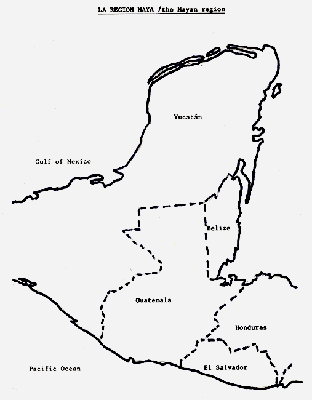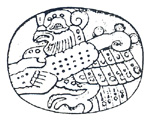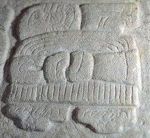Maya Region Notes
2,500 BCE – 1697 CE

I. Pre-Classic: 2,500 BCE (Before Common Era = B.C.) –
353 CE (Common Era = A.D.)
This is the Mayas’
formative period with mound burials that later became temple structures; this
period ends, for instructional purposes, with the invention of the Mayan
calendar of 365 days in 353 CE. The Maya Quiché (one of the cultural and
linguistic groups of the Mayas) calendar is similar to the Yucatecan Maya and
the Aztec calendars. In all three cases they involve a sacred mystery. The Maya
Quiché calendar was based on a "year" known as a "count of
days" (in Maya: tzolk’in; i.e.,
a sunrise to sunrise day, a so-called 24-hour day). They counted a set of 13
deified numbers times 20 days per set of deified number-days to reach this
“count of days” (13 x 20 = 260 days; 260 is also close to the number of days a
human fetus is gestated). In addition, their separate solar calendar (also a
sacred calendar) had 18 months of 20 days per month (18 x 20 = 360 days). (Note
that the Mayas’ mathematical system was constructed on a base of 20—a vestigial
system—rather than the base 10 of the Western system.) To this total of 360 they
added 5 days (negative omen days) during which they enacted elaborate private
and public rituals in order for the sun to rise in exactly the same place and
at exactly the same time a precise solar year later (360 + 5 = 365 days per
solar year; in Maya: a haab year).
Now, for them, a year cycle could only begin on one of 4 of the total of 20
sacred number-days. Hence, they wound up with a 13-year cycle by beginning on
one of the four sacred days (13 x 4 beginning sacred days = 52). The result is
a sacred and cosmological cycle of 52 years, which constituted the practical,
cultural, religious, and social limit of their time periods. But notice that
the mathematics of this cosmological system also projected far into the future.
Here are the terms and calculations for Maya time units:
1 kin = 24 hours
20 kins = 1 uinal
(i.e., 1 month of 20 days)
18 uinals = 1 tun
(i.e., 1 year of 365 days)
20 tuns = 1 katun
(i.e., 7200 days or 20 solar years)
20 katuns = 1
baktun (i.e., 144,000 days or 400 years)
13 baktuns = one
“Great Cycle” or “Long Count” (i.e., 5,126 years) (note: the number 13 comes
from the 13 deified numbers)
5 Great Cycles of
years = 1 Grand cycle (25,630 years; i.e., the length of the precession of the
equinox; the Earth’s “wobble”)
20 baktuns = 1 pictun
(i.e., 2,880,000 days or 8,000 years)
20 pictuns = 1
calabtun (i.e., 1,152,000,000 days or 160,000 years)
20 calabtuns = 1
kinchiltun (i.e., 3,000,000 years)
20 kinchiltuns =
1 alautun (i.e., 23,040,000,000 days or 63,000,000 years)
Note on where the “end of the
world” date of December 12, 2012 as predicted by this Mayan calendar system
comes from. Mayan scholars, professional archeoastronomers, and New Age
astrologers have calculated that the Long Count calendar began on or near
August 11, 3114 BCE. In Mayan notation this date is 13.0.0.0.0. 4 Ahau 8 Cumku,
and it is the same as the “end date” of the Long Count, which would be 5,126
years after the starting day; hence, December 21, 2012 in the modern Gregorian
calendar. In mythical, astronomical, and cosmological terms—including possible
symbolic allusions in the Popol Vuh,
the sacred book of the Mayas, on this date there will be an alignment of two
cosmic axes. On the winter solstice in 2012, the sun will “eclipse” the center,
or “Dark Rift” of the Milky Way galaxy, while the Earth, Moon, and Sun will be
in alignment. For the Mayas, it appears that the center of our galaxy was the
birthplace of all the stars in the “heavens” and that the Dark Rift was the
birthplace of their creator god, known as Hunab K’u. For the ancient, and some
modern, Mayas, the intersection of these two axes at this cosmic alignment
represented, in the cosmos, a duplication of their Sacred Tree. According to
scientific astronomy, however, the alignment of the Earth, Moon, Sun axis with
the center of the Dark Rift in the galactic equator could take place any time
between 1980 and 2016.
Within this long
Pre-Classic period, the first of the great Maya city-states began about 900 BCE
at Tikal, in the northern Petén region of Guatemala, but there had been a small
village of pre-Maya on the site from about 1139 BCE. Then, around 500 BCE, the first astronomical
stone temple was constructed in the Mundo Perdido area of
II. Classic Maya: 353 – 900
The so-called
"Low Classic" period runs roughly from 300 to 700. In this period the
Maya had contact (trade, culture, armed forces, etc.) with Teotihuacán to the
northwest (major civilization near present-day

Mayan classic
culture spreads from Petén at Lake Petén Itzá in present-day

In fact, possibly the greatest figure in Mayan history is the lord emperor
Hasaw Chan K'awil, the 26th ruler of
In 2015, archeology
professor Geoffrey Braswell discovered another major Mayan artifact in Nim Li
Punit, on the edge of the Maya Mountains in southern Belize, which was, as far
as is known, the most southern reach of Mayan civilization. In fact, it is 250
miles south of Chichén Itzá, which is in northern Yucatán Mexico. Nim Li Punit was
inhabited between 350 and 850 CE. The artifact is a jade pendant inscribed with
30 glyphs that tell the story of its original owner among other important
additions to what is known about the Maya and their history. As shown in the
image below, the pendant’s dimensions are 7.4” x 4.1” x 0.3”. Among the
hieroglyphs are the name of the owner, king Janaab’ Ohl K’inich for an
incense-scattering ritual in 672 CE. The pendant was found in a context that
suggests it was used to invoke the Mayan god of wind, which brought the
thunderstorms (and hurricanes) whose rain was essential for Mayan crops and the
prosperity of the Mayan region’s civilization. The information inscribed on
this pendant, therefore, may support the theory that a change in climate in the
Mayan region—i.e., loss of rain and therefore crop failure and famine—may have
been a major contributing factor to the decline of Mayan civilization c.
850-900.

By the end of the
Classic Maya Period, a disastrous change occurred, and the greatest period of
Maya civilization disappeared fast. We do not know precisely what caused this
disaster. Possible explanations are climate change, volcanoes and hurricanes,
drought, overplanting, and others. After 900, Tikal was never re-occupied and
other Mayan areas were invaded by, first, the Toltecs, and, thereafter by the
Aztecs and then the Spanish.
III. Post-Classic: Maya-Toltec (900 – 1527)
A.
Kulkulkán-Quetzalcóatl (legendary leader of the Toltecs at
B. The definitive Toltec conquest of the Mayas occurred in 1098, perhaps when
Ah Zuitok Tutul Xiu (1007 - ?) refounded
C. The peak of this period came about 1200, with Chichén Itzá as the government
and spiritual center. At the same time many Toltec military motifs are
integrated into Mayan art. Kukulkán-Quetzalcóatlt is worshipped as a major
deity. Many Maya-Toltec sites are fortified.
D. About 1400, Chichén Itzá is abandoned. The capital is moved to Mayapán,
which is a walled city. Dissension grows in Mayapán. Mexican-Aztec mercenaries
are imported from
E. The Spanish conquest of the Mayas and their lands occurs from 1527 to 1697.
The first conquistador is Francisco Montejo in upper Yucatán. The conquest of
the Mayas ends in 1697 at
IV. Principal Mayan Gods
A. Hunab Ku (or
Hunab K’u): the supreme being, creator of the world, father of Itzamná. This
god played a fairly minor role among the Mayas.
B. Itzamná: the god of the heavens, day, and night; he was pictured as a
toothless old man who invented writing; he was the first priest, and he was
renowned as a great healer.
C. Chaac (Chac): the god of rain, wind, thunder, lightening, fertility, and
agriculture; Chaac represents the four cardinal points of the compass, and he
was pictured with an upturned, trumpet-shaped nose , two fangs, and a headband.
D. Yum Kax: the god of corn, life, plenty
E. Ah Puch: the god of death; he was pictured with animals of ill omen or as a
skeleton, and he was associated with war and human sacrifices; but sacrifices
were made to other gods too.
F. Ixchel: the goddess of childbirth, the moon, weaving, and floods; she was
pictured as an old woman with claws, a snake on her head, and a skirt covered
in bones.
G. Ixtab: the god of suicide.
H. Kukulkán: the chief Mayan deity during the Maya-Toltec period; god of wind, light, life, water; a demigod believed to be the founder of civilization and Chichén Itzá.
I. Many more gods: of war, merchants,
mountains, home hearths, warriors, women, etc.
V.
Principal Mayan Gods in Popol Vuh
(duality, dualism)
A. Heart of
Heaven: principal god with dual nature: Gucumatz, Tepeu, Huracán; and double
nature (maker / creator)
B.
Tepeu (creator) / Gucumatz (maker): forefather gods (Gucumatz, Quiché Maya =
Kukulkán, Yucatecan Maya = Quetzalcóatl, Aztecan Náhuatl)
C.
Soothsayers: Grandmother (day: Xmucané; corn goddess; step-grandmother of the
Hero Twins) and Grandfather (dawn: Xpiyacoc; step-grandfather of the Hero
Twins) = maker and creator
VI.
Four Creation Attempts (the Four Ages) in Popol
Vuh Cosmology
A. Earth,
mountains, trees, animals
B.
Human beings made of clay and mud
C.
Soulless human beings made of wood like stick dolls
D. Modern or “true” human beings made from corn dough
(E. For
Mayan creation cosmology, the “fifth
age,” is yet to come. For them, the fifth age includes the return of
Kulkulkan (Quetzalcóatl). For the Aztecs, the fifth age, or Fifth Sun, was
interrupted at the time of the Spanish conquest in the sixteenth century.)
VII.
Brief Notes on Maya Architecture
Here are several notions that help
appreciate Maya architecture at


